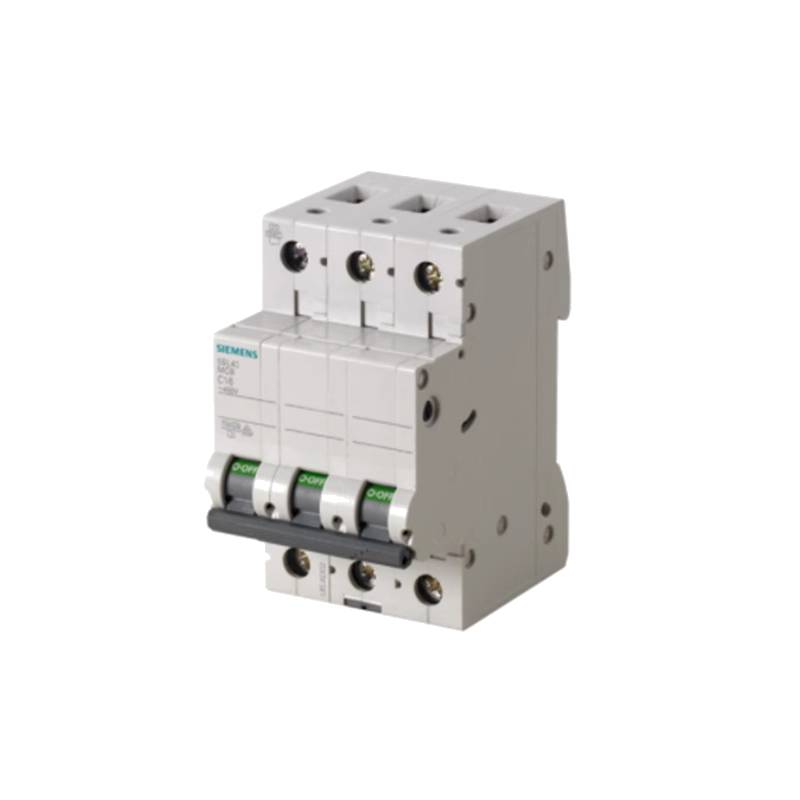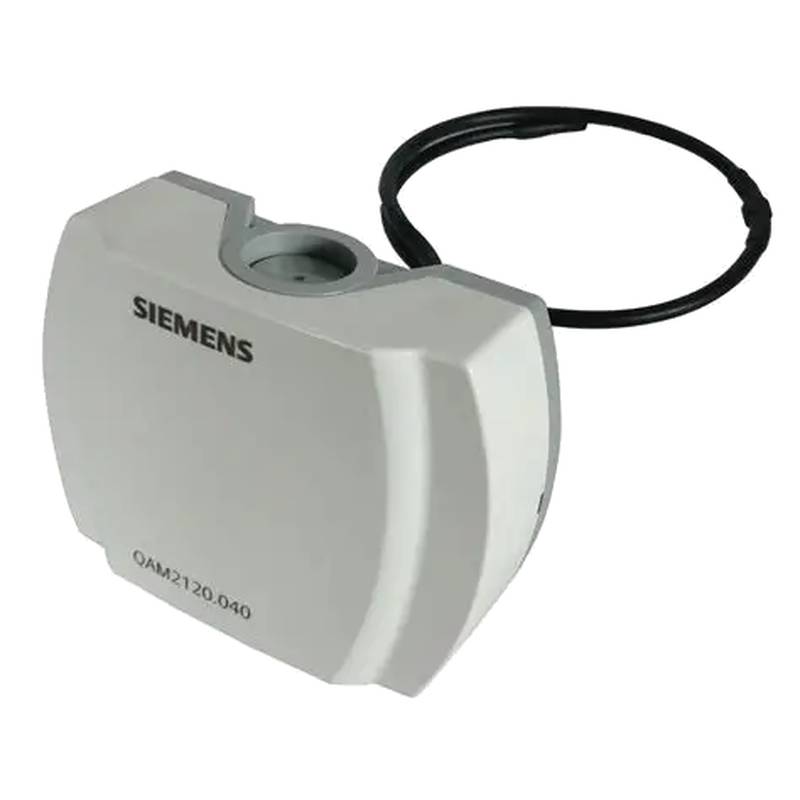
The Siemens 5SN6363-8CN Miniature Circuit Breaker (MCB) stands as a robust solution for electrical protection, offering exceptional reliability for industrial and commercial applications. This 3-pole, 63A MCB is engineered with advanced thermal-magnetic trip technology, ensuring rapid and precise disconnection under fault conditions, thereby safeguarding valuable equipment and personnel. Its key advantages include superior breaking capacity, enhanced durability, and seamless integration into standard distribution systems. Technical specifications highlight its 3-pole configuration, a rated current of 63A, and a breaking capacity of 6kA, making it suitable for demanding environments.
Siemens 5SN6363-8CN: Product Specifications
| Feature | Specification |
| :----------------------- | :------------------------------------------ |
| Product Type | Miniature Circuit Breaker (MCB) |
| Poles | 3-Pole |
| Rated Current (In) | 63A |
| Breaking Capacity (Icn) | 6kA |
| Rated Voltage (Un) | 400V AC |
| Trip Curve | C-Curve (typically for inductive loads) |
| Frequency | 50/60 Hz |
| Mounting Type | DIN Rail |
| Degree of Protection | IP20 |
| Operating Temperature | -25°C to +55°C |
| Compliance Standards | IEC/EN 60898-1, IEC/EN 60947-2 |
| Material | High-quality, flame-retardant thermoplastics |
| Terminal Type | Screw terminals |
| Connection Capacity (max) | 25 mm² |
| | |
Core Features & Market Positioning
The Siemens 5SN6363-8CN MCB distinguishes itself through its commitment to safety and operational efficiency. Its robust construction, utilizing high-quality, flame-retardant thermoplastics, ensures longevity and resilience in harsh industrial settings. The C-curve trip characteristic is particularly advantageous for applications with moderate inductive loads, providing optimal protection without nuisance tripping. This focus on reliability and advanced protection mechanisms positions the 5SN6363-8CN as a preferred choice for electrical engineers and system integrators seeking dependable circuit protection solutions that comply with stringent international standards like IEC/EN 60898-1 and IEC/EN 60947-2.
Key Application Scenarios
This Siemens 3P 63A MCB is ideally suited for protecting main incomers and branch circuits in industrial power distribution panels, control cabinets, and machinery. Common applications include safeguarding motors, transformers, and lighting circuits where a reliable and timely response to overcurrent and short-circuit faults is paramount. Its 6kA breaking capacity is sufficient for many standard industrial installations, offering effective protection against damaging electrical events. Furthermore, its compatibility with standard DIN rail mounting simplifies installation across various switchboard configurations.
Practical System Integration Guidance
Integrating the Siemens 5SN6363-8CN MCB into existing electrical systems is straightforward, owing to its standard DIN rail mounting and screw terminal connections. For optimal performance and safety, ensure proper torque is applied to the terminal screws (typically 2.5-3 Nm) to secure the conductors, which can accommodate up to 25 mm² wire. Always connect the line conductors to the top terminals and the load conductors to the bottom terminals for correct operation and to adhere to safety regulations. Pre-installation checks, including verifying the supply voltage and ensuring the MCB's rating aligns with the circuit's protective requirements, are critical for a successful and safe installation.
Operation and Risk Mitigation
Proper operation of the Siemens 5SN6363-8CN MCB ensures the safety and integrity of electrical systems. The device automatically trips and interrupts the circuit upon detecting an overcurrent or short circuit, indicated by the position of the toggle lever. To reset the breaker after a fault, the lever must be moved to the "OFF" position before being pushed firmly to the "ON" position. Common troubleshooting involves identifying the root cause of the tripping, such as overloaded circuits, shorted equipment, or faulty wiring, rather than repeatedly resetting the MCB without addressing the underlying issue. Regular visual inspections for any signs of damage or overheating are recommended as part of a preventative maintenance strategy.
Scalability & Long-Term Value
The Siemens 5SN6363-8CN MCB offers considerable long-term value through its compatibility with Siemens' broader range of industrial electrical components and its robust design, which minimizes the need for frequent replacements. Its modular nature allows for easy addition or substitution within standard distribution boards, facilitating system upgrades or expansions. While this specific model is a standalone protection device, it forms part of Siemens' comprehensive portfolio of industrial automation and power distribution solutions, which increasingly integrate with IIoT platforms for enhanced monitoring and predictive maintenance capabilities, allowing for future integration into smarter electrical networks.
Frequently Asked Questions (FAQs)
Q1: What is the primary function of the Siemens 5SN6363-8CN MCB?
This MCB provides overcurrent and short-circuit protection. It automatically interrupts electrical circuits to prevent damage to equipment and ensure safety.
It serves as a crucial safety device in industrial and commercial electrical installations. Its mechanism protects against electrical faults that could otherwise lead to fires or equipment failure.
The device ensures operational continuity by preventing minor faults from escalating into major system disruptions. It is a fundamental component for reliable power distribution.
Q2: What does the "3P 63A" designation signify for this MCB?
"3P" indicates that the circuit breaker has three poles. This means it can simultaneously interrupt all three phases of a three-phase electrical system.
"63A" denotes the rated current (In) of the device. This is the maximum continuous current the MCB can carry under normal operating conditions without tripping.
Using a 3-pole breaker is essential for properly protecting three-phase equipment and systems, ensuring balanced protection across all phases.
Q3: Can this MCB be used for both residential and industrial applications?
While designed for industrial robustness, its adherence to IEC standards makes it suitable for high-demand residential or commercial settings. It offers superior protection compared to standard residential breakers.
Its 6kA breaking capacity is well-suited for industrial environments with higher fault current potential. For typical homes, a lower breaking capacity MCB might suffice.
Always consult local electrical codes and a qualified electrician to determine the appropriate MCB rating and type for any specific application, including residential use.
Q4: What is the significance of the "C-Curve" on this Siemens MCB?
A C-curve breaker is designed to trip between 5 to 10 times the rated current. This characteristic is suitable for circuits with moderate inductive loads, such as motors or transformers.
It provides a balance between protecting against short circuits and preventing nuisance tripping from inrush currents common in inductive loads. This reduces unnecessary downtime.
If your application involves high inrush current devices, a C-curve offers better performance than an A or B curve, but if instantaneous tripping is needed for very sensitive loads, other curves might be considered.
Q5: How does the 6kA breaking capacity of the 5SN6363-8CN impact its application?
The 6kA breaking capacity signifies the maximum fault current the MCB can safely interrupt without being damaged. This is a critical safety parameter for system design.
This rating is generally adequate for many standard industrial and commercial distribution circuits where the prospective fault current is below 6,000 Amperes.
For installations where the potential fault current is higher than 6kA, a higher breaking capacity MCB (e.g., 10kA or more) or additional protective devices like fuses would be necessary to ensure safety.
Q6: What type of loads is the Siemens 5SN6363-8CN MCB best suited for?
It is ideal for protecting inductive loads such as motors, transformers, and fluorescent lighting ballasts. These loads often have higher startup current demands.
Its C-curve tripping characteristic ensures that the MCB does not trip unnecessarily during the brief inrush current phase when these loads are energized.
For purely resistive loads like heaters or incandescent lights, a B-curve MCB might be sufficient and offer more sensitive overload protection.
Q7: Is the Siemens 5SN6363-8CN compatible with other brands of distribution boards?
Yes, the 5SN6363-8CN is designed for standard 35mm DIN rail mounting. This ensures broad compatibility with most standard industrial distribution boards and enclosures.
Siemens MCBs, like this one, are manufactured to international standards (IEC/EN), which promotes interchangeability among reputable brands that also adhere to these same standards.
However, for critical applications or to ensure warranty compliance, using components from the same manufacturer or confirming compatibility with the board manufacturer is always advisable.
Q8: What are the environmental operating conditions for this MCB?
This MCB is designed to operate reliably within a temperature range of -25°C to +55°C. This wide range makes it suitable for various industrial environments.
It has a degree of protection of IP20, meaning it is protected against solid objects larger than 12.5mm and offers no protection against water. It should be installed in an enclosure to protect it from dust and moisture.
Ensure the installation location respects these environmental limitations to maintain the breaker's performance and lifespan. Avoid exposure to excessive moisture, corrosive atmospheres, or extreme temperatures outside its specified range.
Q9: How do I properly wire the Siemens 5SN6363-8CN MCB?
Connect the incoming power supply to the top terminals and the outgoing load wires to the bottom terminals. This ensures correct operational direction and safety.
Use appropriate size conductors (up to 25 mm²) and ensure they are securely fastened with the correct torque applied to the screw terminals. Refer to the manual for specific torque values.
Always de-energize the circuit completely before wiring and follow all local electrical codes and safety regulations. Double-check connections before re-energizing the system.
Q10: What safety precautions should be taken when installing or operating this MCB?
Always ensure the main power supply is switched off and locked out before performing any installation or maintenance. Verify with a voltage tester that the circuit is dead.
Use appropriate personal protective equipment (PPE), such as safety glasses and insulated gloves, when working with electrical equipment. Never touch live terminals.
If the MCB trips repeatedly, do not force it back on. Identify and rectify the underlying fault condition; consult a qualified electrician if you are unsure.























